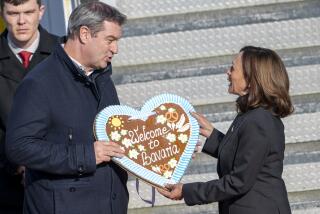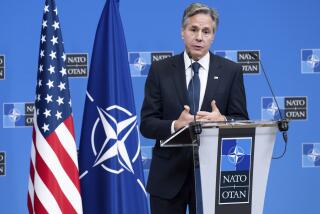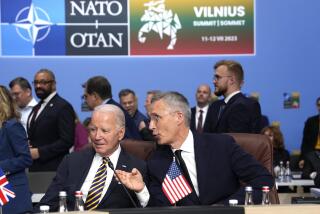Clinton’s Plan for Europe Faces an Uphill Battle at Home
- Share via
PARIS — From the start of his current European swing, President Clinton has tried to convey one overriding message: The historical parallel for his controversial initiative to redraw the security map of Europe is the Marshall Plan.
Tactically, the comparison makes political sense.
The late Secretary of State George C. Marshall’s plan to give an exhausted Europe billions of dollars to rebuild from the ashes of World War II was wildly successful. It accomplished more, cost less and finished sooner than anyone expected. It generated immeasurable transatlantic goodwill as well as lucrative markets for U.S. goods.
Traveling to a grateful and prosperous Western Europe for the Marshall Plan’s 50th anniversary celebrations, replete with a large “Thank You, America” rally in the Dutch city of Rotterdam today, is a made-to-order opportunity for the beleaguered president.
But as Clinton strains to sell his new vision for Europe as a kind of Marshall Plan II, it is the differences, not the similarities, in circumstances after 50 years that stand out.
Clinton’s initiative--engaging Russia while enlarging the North Atlantic Treaty Organization and extending U.S. nuclear guarantees deep into Central Europe--unfolds in a radically different economic and political climate than did the Marshall Plan. The size of the differences, both in Europe and in the United States, makes Clinton’s job of selling his plan to Congress and the American people extremely difficult.
In 1947, the Marshall Plan responded to a clear, identifiable danger: the ominous shadow of Soviet communism. By the time Marshall proposed his idea, in June 1947, to use American money to rebuild Europe, Moscow had already absorbed much of Eastern Europe and was threatening to move farther west through powerful Communist parties in France and Italy.
Other important factors also worked to Marshall’s advantage. The Communist threat had been clearly defined, first to insiders in the famous “long telegram” from then-U.S. Ambassador to Moscow George F. Kennan, then more publicly in Winston Churchill’s famous “Iron Curtain” speech. And if there were any doubts about Europe’s need, photos of war-caused damage and deprivation conveyed their own powerful message.
The Marshall Plan was also a clean, simple offer that treated the vanquished on equal terms with the victors, that effectively excluded Moscow and that left no gray zones in between.
Clinton has none of these advantages.
Today’s dangers to European security may be just as real as those in 1947, but they are hard to identify and even harder to explain or understand. Without an easily defined enemy and the rallying cry to oppose the Communist menace, many Americans find it difficult to see why they should get involved. The lukewarm public support for U.S. involvement in Bosnia-Herzegovina underscores this ambivalence.
Adding to this is the tough question of why, half a century later, the United States should still be viewed as the “indispensable nation” needed to guarantee peace in Europe. Bosnia may have proved that view true, but the reasons are more subtle and harder to explain than 50 years ago, when America’s military, economic and political might so clearly dominated the free world.
Europe in 1997 is also hardly on its knees.
While Marshall Plan aid went to a group of countries that had nowhere to go but up, Clinton is moving to extend America’s security guarantees on a continent whose western half is rich beyond its dreams but also has an aging population, lavish welfare benefits and fading competitiveness that have led many observers to conclude it has nowhere to go but down.
For West Europeans, the political debate seems focused far more on how to maintain present living standards, with their short workweeks and long vacations, than on efforts to stabilize the new democracies of Central and Eastern Europe. The heads-down, six-day-a-week work ethic that characterized much of Western Europe in the 1950s and helped convert Marshall Plan money into dynamic economic growth has given way to a collective search for more time off.
While Western Europe turned to the United States half a century ago because it was incapable of fending for itself, today many observers ask whether America’s new guarantees are merely compensating for a reluctance on the part of the continent’s richer nations to assume a greater share of responsibility for their region’s security.
Because of this, Clinton’s initiative could generate a transatlantic debate over how to divide the costs of NATO’s enlargement. The U.S. has proposed that Europeans pay most of the bill, presently estimated at about $2 billion to $3 billion annually over 10 years.
The United States too has undergone profound change.
Transatlantic trade, which once formed the heart of overseas American business, has slipped in importance. Today, U.S. trade with the Pacific Rim nations exceeds that with Europe; it totaled $463 billion in 1995, compared with $265 billion with the European Union.
Population shifts have also left their mark. The number of Asians living in the United States is expected to jump from 3.7 million in 1980 to more than 34 million by the middle of the next century.
Why, Americans may ask, is Clinton extending U.S. commitments to Europe on the eve of what many see as the Pacific century?
Even in the clear-cut climate of the late 1940s, President Truman faced stubborn resistance to the Marshall Plan in Congress.
“It was not an easy sell,” recalled Lincoln Gordon, a former U.S. ambassador who helped implement the Marshall Plan. “The country had been spending a lot of money and didn’t like the idea of continuing large expenditures.”
Clinton and those around him are aware that winning both Senate ratification and public support for NATO enlargement won’t be easy.
In preparation for the fight, Clinton had four lawmakers with him in Paris, including Sens. William V. Roth Jr. (R-Del.) and Gordon Smith (R-Ore.) and Bay Area Democratic Rep. Nancy Pelosi.
“We’re at the beginning or just prior to the beginning of a real full [congressional] debate on this question,” White House spokesman Mike McCurry said Tuesday. “I wouldn’t hazard a guess where the majority of Congress is on this issue, but we’ll need a [two-thirds majority] vote and that means we’re going to have a lot of hard work in the year-plus ahead.”
(BEGIN TEXT OF INFOBOX / INFOGRAPHIC)
Helping Europe--Then and Now
President Clinton has been touting his European initiative as a second version of the Marshall Plan, the U.S. effort that began in 1947 to rebuild Europe. Here’s how the situation is different today:
*--*
Category Europe Then Europe Now Europe’s economic In 1947, Europe had In 1997, Europe is future nowhere to go but up. prospering but vulnerable. Foreign threat The Soviet Union and There is no obvious communism provided a menace. clear threat. U.S. strength United States was Europe’s economic clout dominant economic eclipses the United power. States’ in some areas.
*--*
More to Read
Get the L.A. Times Politics newsletter
Deeply reported insights into legislation, politics and policy from Sacramento, Washington and beyond. In your inbox twice per week.
You may occasionally receive promotional content from the Los Angeles Times.










